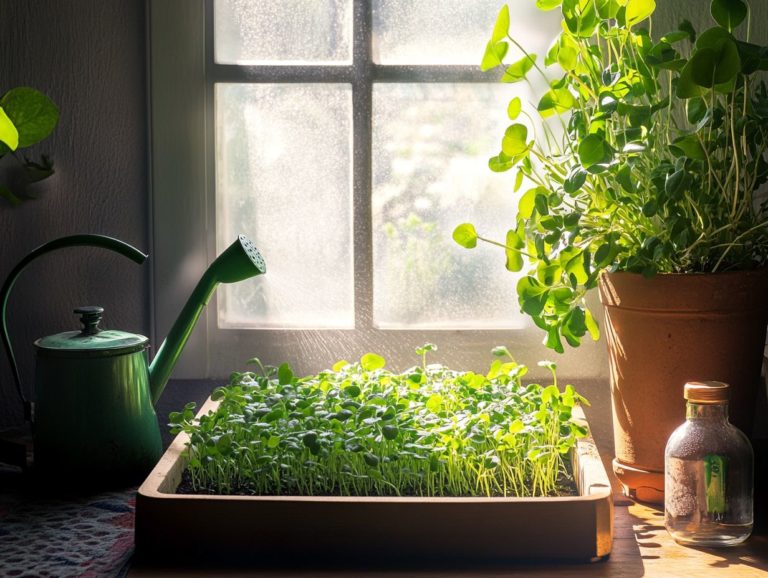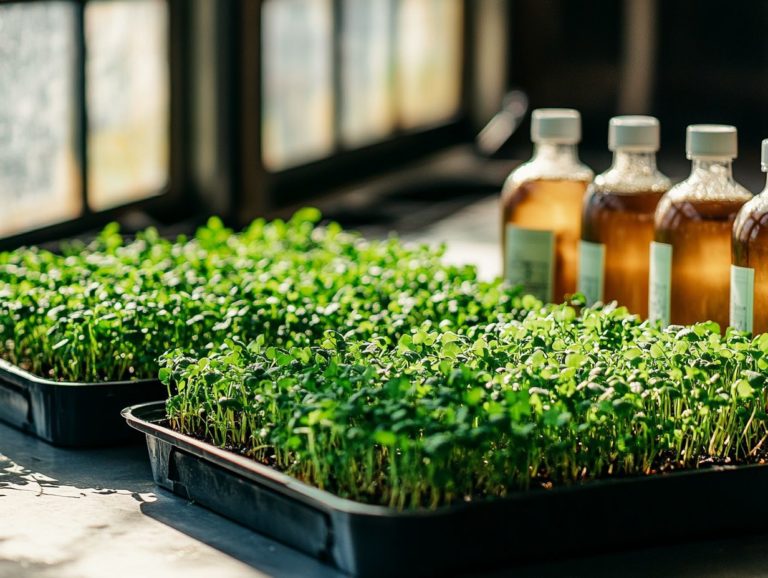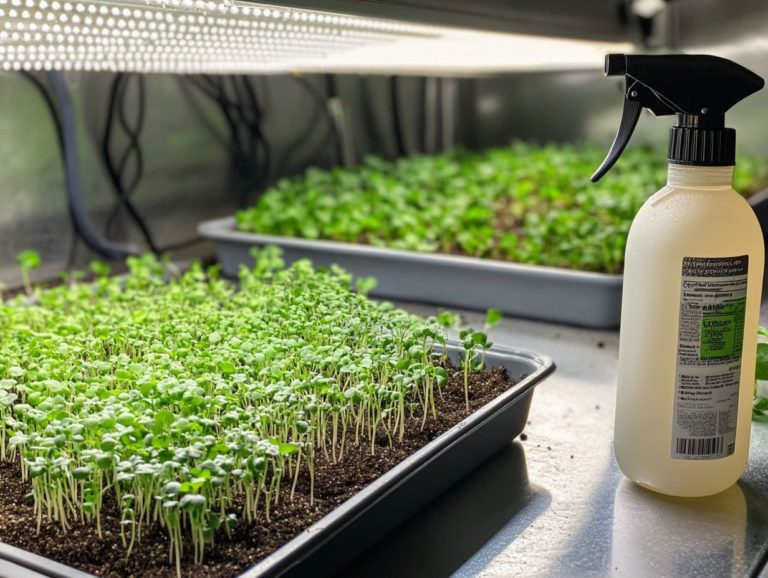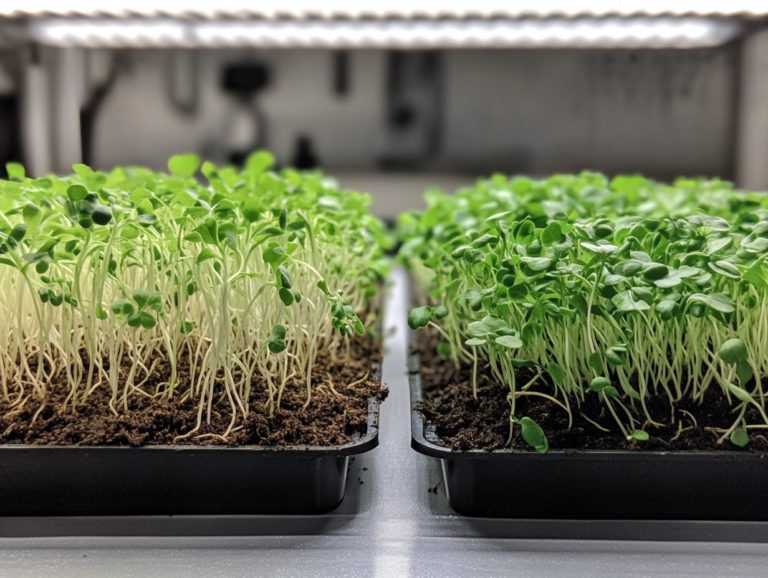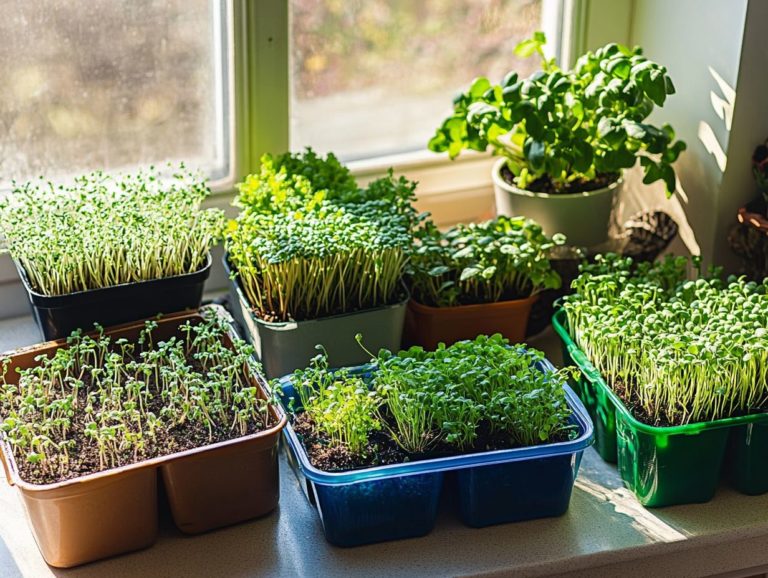Essential Care Tools for Microgreen Plants
Microgreens are small, nutrient-dense greens that can transform your meals and provide a wealth of health benefits. If you re aiming to elevate your diet or cut down on grocery expenses, cultivating these vibrant greens at home is a gratifying endeavor.
This guide will walk you through the nutritional perks of microgreens, the essential tools for successful growth, common missteps to avoid, and best practices for harvesting and storing your greens. This ensures they retain maximum freshness and flavor in your home gardening experience.
Uncover just how simple and rewarding growing microgreens can be!
Contents
- Key Takeaways:
- Benefits of Growing Microgreens
- Essential Tools for Growing Microgreens
- Common Mistakes to Avoid
- Troubleshooting Common Issues
- Harvesting and Storing Microgreens
- Frequently Asked Questions
- What are essential care tools for microgreen plants?
- Why do I need a spray bottle for my microgreen plants?
- Can I use regular tweezers for my microgreen plants?
- What is the purpose of a misting dome for microgreen plants?
- How often should I water my microgreen plants?
- Why is a grow light important for microgreen plants?
Key Takeaways:
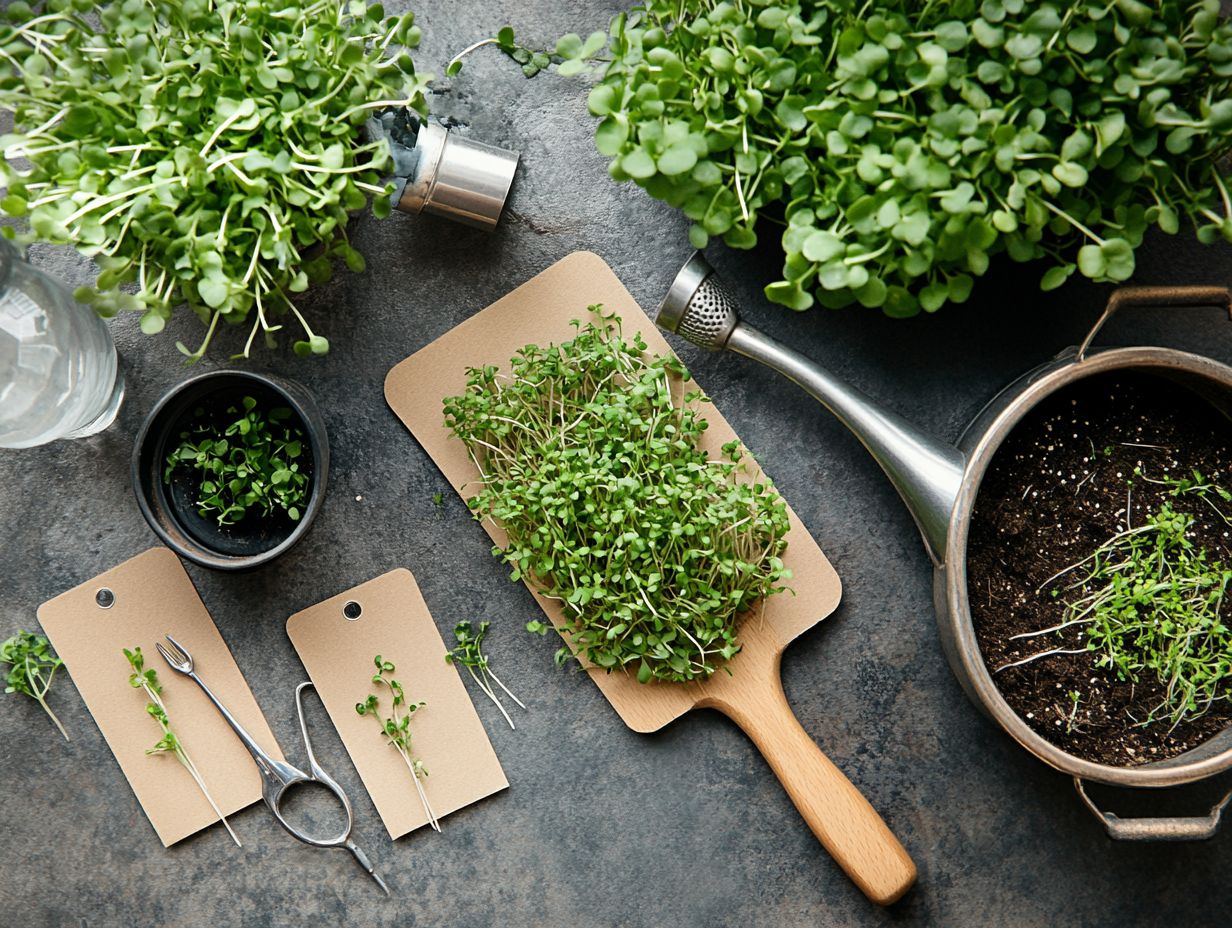
- Microgreens are nutrient-dense, cost-effective plants that can be grown at home.
- Containers, lighting, and proper watering are essential tools for successfully growing microgreens.
- To avoid common mistakes, pay attention to watering, lighting, and growing medium, and properly harvest and store microgreens.
What are Microgreens?
Microgreens are your ticket to a vibrant home garden, harvested just after those first true leaves make their appearance. These young, edible plants are packed with flavor and nutrition. They are perfect for salads or as eye-catching garnishes, often dubbed ‘vegetable confetti’ for their colorful flair and health benefits.
With options like pea shoots and mustard microgreens, you can easily grow them using seeds and a few simple tools. This method offers a quick and cost-effective way to boost your food production.
As home gardening gains popularity, microgreens thrive right on your windowsill or small balcony, requiring minimal resources while maximizing yield. Varieties like radish, broccoli, and sunflower each bring unique tastes and textures to your table.
Their rapid growth cycle often just one to three weeks makes them an enticing choice for anyone eager to cultivate fresh produce without the lengthy wait associated with traditional gardening. Plus, the abundant vitamins and antioxidants found in these tiny greens support a healthy diet, significantly contributing to your overall wellness.
Benefits of Growing Microgreens
Growing microgreens presents numerous advantages you can t overlook. These tiny powerhouses are packed with nutritional value, allowing you to elevate your meals effortlessly.
Not only do they provide substantial cost savings for home gardeners, but they also offer the unparalleled convenience of having fresh vegetables right at your fingertips.
- Nutritional value that elevates your meals.
- Significant cost savings for home gardeners.
- Convenience of having fresh vegetables at your fingertips.
Nutritional Value and Cost Savings
Microgreens are a fantastic way to supercharge your meals! They offer a wealth of vitamins and minerals that elevate a healthy diet, all while being a budget-friendly option for your home gardening endeavors. Varieties like pea shoots and mustard microgreens can deliver up to 40 times the nutrients of their mature counterparts, making them an extraordinary addition to your culinary creations.
These tiny powerhouses are brimming with antioxidants and essential vitamins A, C, E, and K, alongside vital amino acids and minerals such as magnesium and iron. Using special solutions that help plants grow without soil boosts their growth.
Growing microgreens at home can save you a significant amount compared to buying them at retail prices, which usually come with inflated overhead costs. Setting up a straightforward indoor growing system requires minimal space and investment. Just a few seed packets can yield a continuous supply of fresh greens for your salads, sandwiches, and garnishes, making it an affordable option.
This results in health benefits and savings over time, making microgreens a wise addition to your kitchen. Start your microgreen journey today and taste the difference in your meals!
Essential Tools for Growing Microgreens
To successfully grow microgreens at home, you’ll need a few essential tools. Start with high-quality seeds and the right growing container, along with growing medium designed to create optimal growth conditions.
Investing in items like watering trays, measuring cups for precise moisture levels, and a dependable light source can elevate your gardening experience. Consider using the best containers for microgreen cultivation to ensure that your nutrient-dense greens flourish beautifully, whether they’re basking on your kitchen windowsill or thriving in dedicated growing trays.
Top Containers and Growing Medium for Success
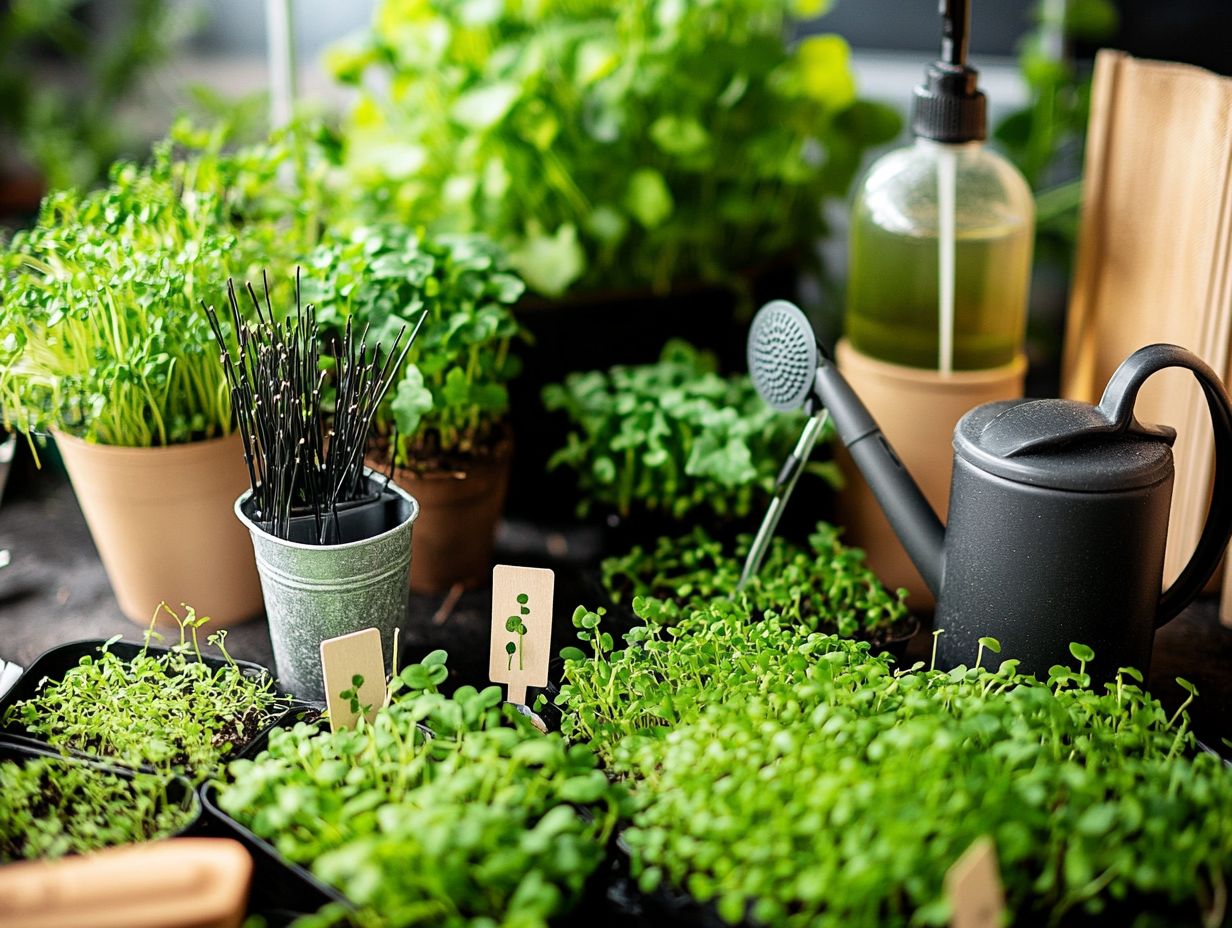
Choosing the right containers and growing medium is essential for cultivating microgreens, as these elements directly influence growth rates and overall plant health. You have various options, from traditional potting soil to specialized water-based growing materials, each bringing unique benefits, including the ability to use composting (using organic waste to create nutrient-rich soil) and pH testing for better results.
If you re leaning towards organic seeds, consider incorporating compost to boost nutrient availability and provide a balanced nutrient solutions.
Among the container choices, plastic containers are a popular pick due to their lightweight design and flexibility. Growth trays featuring drainage holes are also wise, as they facilitate effective water management. If sustainability is important to you, consider using biodegradable pots made from coconut coir or peat as eco-friendly alternatives, especially when paired with nutrient solutions.
When selecting a growing medium, think about your goals: do you want rapid growth or enhanced flavor? For instance, coconut coir is excellent at retaining moisture, which can speed up germination. By aligning the container size with your available space and the specific types of microgreens you’re cultivating, you can streamline the process and ensure healthy, robust plants that thrive in their environment. To learn more about this, check out our guide on harvesting microgreens: tools of the trade.
Lighting and Temperature Control
Proper lighting and temperature control are essential for your microgreens to thrive, ensuring they receive just the right amount of sunlight or artificial light necessary for optimal growth.
Choosing the right type of light source is critical; you have options like fluorescent and LED lights, as well as specialized grow lights. Each offers different light spectra that significantly affect plant development. For example, blue light encourages leafy greens, while red light promotes flowering and fruit production.
Maintaining a temperature range between 60 F and 75 F is equally important, as this sweet spot fosters rapid germination and maturation. Adding a small fan not only improves air circulation but also helps strengthen the stems, resulting in sturdier plants.
When you combine all these elements, you create an environment that cultivates lush, vibrant microgreens brimming with flavor and nutrients, ensuring optimal sunlight exposure and air circulation.
Start growing your microgreens today and enjoy fresh, nutritious greens right from your kitchen!
Watering and Nutrient Management
Effective watering and nutrient management are crucial elements in your journey to grow microgreens. They significantly impact moisture levels and overall plant health. To deliver just the right amount of water, consider using watering trays and measuring spoons.
Incorporating plant food can also boost growth performance, especially when working with pre-soaked seeds in hydroponics a method of growing plants in water instead of soil and using a watering can for precise watering.
To achieve optimal moisture levels, regularly check the soil s surface and adjust your watering practices as necessary. A moisture meter can be a fantastic tool, providing accurate readings of moisture content.
When selecting plant food, aim for a balanced mix that includes essential elements like nitrogen, phosphorus, and potassium, particularly for hydroponically grown varieties. Diluting the plant food according to the package instructions ensures your microgreens receive the right dosage, encouraging vibrant growth and maximizing yields. Additionally, using the essential tools for harvesting microgreens can further enhance your gardening success.
By adhering to these best practices and maintaining a consistent routine, you’ll be amazed at how easy it is to grow lush microgreens using sprouting trays for microgreens with minimal hassle, all while enjoying the benefits of compact gardening.
Common Mistakes to Avoid
Avoiding common mistakes is essential for successfully cultivating microgreens. Missteps like overwatering, underwatering, or selecting the wrong growing medium can hinder the germination process and diminish yields.
Understanding the importance of maintaining the right lighting and temperature is key! These factors play a significant role in the health and vitality of your nutrient-dense greens.
Overwatering and Underwatering
Overwatering and underwatering are two of the most common pitfalls when growing microgreens. Both can seriously compromise plant health if you neglect proper moisture retention. By understanding moisture retention in your growing medium and selecting the right watering can, you can maintain ideal moisture levels that support the germination process and promote the growth of your nutrient-dense greens, ultimately leading to a more successful harvest.
Recognizing the signs of overwatering such as yellowing leaves or root rot is vital for you as a grower. Conversely, underwatering can lead to wilting and stunted growth. Routinely assess the soil s moisture level; the top inch should be slightly moist, but definitely not saturated.
Using a watering can with a narrow spout offers you precise control, allowing for gentle watering that won’t overwhelm your plants. A moisture meter can greatly help in maintaining consistent moisture levels, ensuring that your microgreens thrive in the optimal environment. For more detailed guidance, check out these essential tips for growing microgreens at home.
Improper Lighting and Temperature
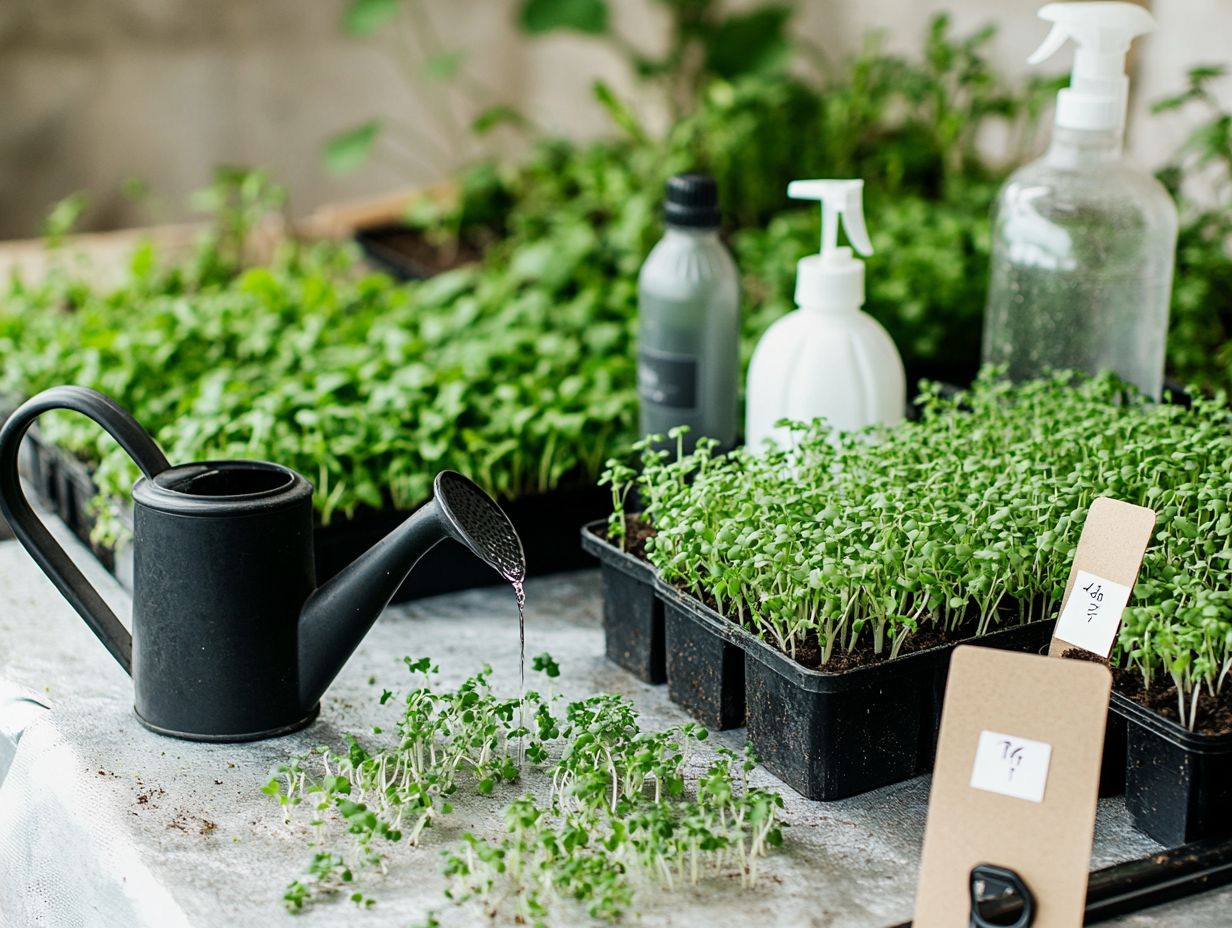
Improper lighting and temperature control can severely hinder your microgreens’ growth. Understanding these requirements is essential for ensuring vibrant, healthy plants.
Utilize effective artificial light setups or get plenty of sunlight to create an ideal environment that promotes robust germination and growth.
Poor lighting can lead to tall, weak plants that lack flavor, while excessive heat can cause wilting or stunted growth. Invest in grow lights to create the best environment for your greens, providing full-spectrum illumination, which means the light includes all colors necessary for plant growth.
If you rely on natural sunlight, a south-facing window is your best bet. Don t forget to rotate your trays regularly to ensure even growth.
Maintaining a temperature range of 60-75 F (15-24 C) is crucial for the development of strong microgreens, allowing them to flourish and reach their full potential.
Using the Wrong Growing Medium
Choosing the wrong growing medium can lead to stunted growth and poor quality microgreens. The substrate you select is a pivotal part of the growing process.
Microgreens thrive in a medium that retains moisture while allowing proper drainage. This balance can differ based on the specific variety you re cultivating.
For example, potting soil offers a rich nutrient base and excellent water retention, but it may struggle with drainage. On the other hand, hydroponic media, which are soilless growing materials that provide nutrients, like coconut coir or rock wool, offer superior aeration and drainage, often leading to faster growth rates.
Organic compost introduces beneficial microbes for a vibrant ecosystem, but it can sometimes lack the structure to support delicate seedlings. Assess these factors to make informed decisions tailored to your microgreen varieties, ultimately enhancing both yield and quality.
Troubleshooting Common Issues
Troubleshooting common issues like pests and diseases is vital for nurturing a thriving microgreen garden. These factors can greatly influence both growth and yield.
Ensure proper air circulation and supply a balanced nutrient solution to effectively mitigate these challenges. Act now to ensure your microgreens thrive!
Identifying and Treating Pests and Diseases
Identifying and addressing pests and diseases promptly is essential for safeguarding your microgreens against potential damage and yield loss. Common threats, such as aphids and mold, can wreak havoc. Maintaining proper air circulation significantly reduces the risk of infestations, allowing your nutrient-dense greens to thrive.
As a grower, regularly inspect your crops for pests like spider mites and whiteflies, which can multiply rapidly if not managed early on. Look out for signs of mold, such as fuzzy spots or a musty odor; they might mean your humidity levels need adjusting.
Implementing methods to control pests like introducing beneficial insects or using organic pesticides can provide effective solutions. Don’t overlook environmental factors! Temperature and light exposure are crucial for the health of your microgreens. Additionally, if you’re looking to enhance your growing experience, consider how to create a microgreen grow kit to keep your growing conditions optimal and quickly fend off pests and diseases!
Incorporating routine sanitation practices and crop rotation will also help prevent infestations, ultimately ensuring you reap a bountiful harvest.
Harvesting and Storing Microgreens
Harvesting and storing microgreens with precision is essential for preserving their freshness and maximizing their nutritional value. This allows you to savor these nutrient-dense greens at their peak flavor.
Adopt best practices during the harvesting process like using kitchen scissors for clean, precise cuts to ensure that the integrity of your microgreens remains intact until they are ready to be stored or served.
Best Practices for Harvesting and Storage
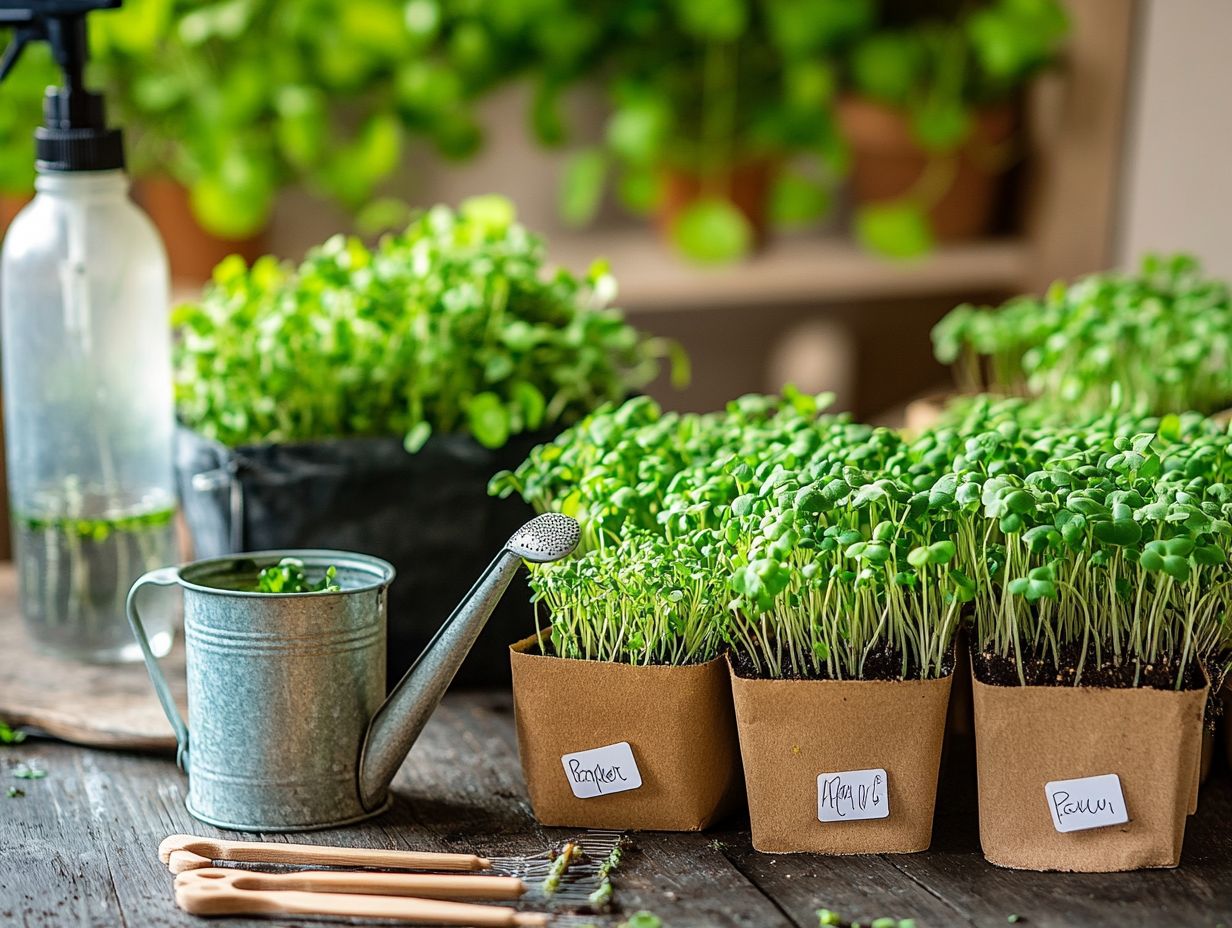
Applying best practices for harvesting microgreens is crucial to maintaining their freshness and quality. Using kitchen scissors is a favored method for achieving a clean and efficient cut. After the harvest, proper storage techniques significantly enhance their shelf life, ensuring you have a continuous supply of nutrient-dense greens.
Timing is equally vital; harvest your microgreens at their peak typically between 7 to 21 days after germination to guarantee optimal flavor and nutritional content. Using sharp knives or dedicated harvesting scissors minimizes damage to those delicate plants, preserving their vibrant colors and textures. Additionally, understanding watering techniques for thriving microgreens can further enhance their growth and quality.
Once harvested, store your microgreens in breathable containers placed in a cool, dark environment to prolong their freshness. Utilizing damp paper towels or breathable bags helps manage excess moisture, preventing spoilage while retaining essential vitamins and minerals.
By integrating these practices into your routine, you will not only elevate the quality of your microgreens but also enjoy delicious and nutritious additions to your meals.
Frequently Asked Questions
What are essential care tools for microgreen plants?
Essential care tools for microgreen plants include a spray bottle, tweezers, a small gardening shovel, a watering can, a grow light, and a misting dome. Consider using plant tags to label your varieties.
Why do I need a spray bottle for my microgreen plants?
A spray bottle is necessary for misting the microgreen plants, providing them with the moisture and nutrients they need to thrive.
Can I use regular tweezers for my microgreen plants?
It is recommended to use small, precision tweezers specifically designed for gardening to avoid damaging the delicate microgreen plants.
What is the purpose of a misting dome for microgreen plants?
A misting dome helps create a humid environment for the microgreen plants, promoting healthy growth and preventing them from drying out.
How often should I water my microgreen plants?
Microgreen plants should be watered once or twice a day, depending on the type of plant and the moisture needs of its specific variety.
Why is a grow light important for microgreen plants?
A grow light is crucial for microgreens. It gives them the light they need to grow strong and healthy.
This light helps with photosynthesis, which is how plants make their food. Without it, your microgreens won’t thrive!

